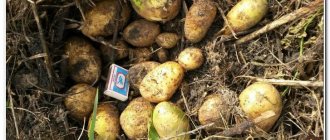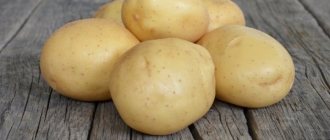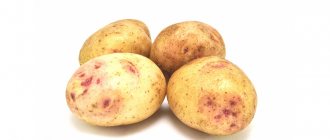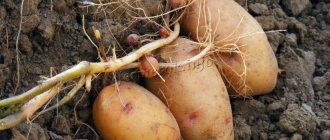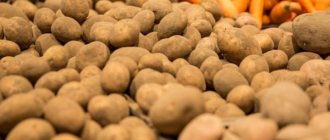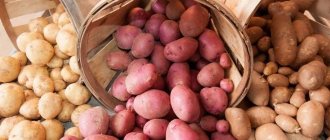The potato crop has more than four thousand varieties. They differ in taste, size, peel color, and ripening time. Also one of the main parameters is the keeping quality of the vegetable. The ability of potatoes to retain their external and taste properties until spring is very important.
When choosing the most suitable potato variety for winter storage, you should be guided by a number of factors, and also follow recommendations for creating optimal conditions in storage.
What does keeping quality depend on?
Many factors influence the long-term shelf life of potatoes. Let's look at them in order.
Genetic characteristics of the variety
Depending on the timing of ripening, the following varieties are distinguished: early, mid-ripening and late. The former are suitable for consumption in summer and autumn, since they can generally be stored only until November. And the second two can last until spring.
Weather
With heavy rainfall, oxygen is displaced from the soil, and the tubers “suffocate,” which become more easily infected with diseases during further transportation and storage. If the summer was cool and rainy, potato losses may increase by one and a half to two times.
Soil Features
Potatoes grown on light sandy loam soils store well. The crop also grows well, producing a high-quality harvest, on black soil and peat soil.
Fertilizer application
The correct use of mineral fertilizers is very important. With an excess of nitrogen, tubers contain more sugars, which increases the intensity of respiration and, as a result, susceptibility to disease. Also, a lack of potassium fertilizers leads to deterioration in keeping quality.
Harvesting
Timely harvesting of potatoes and proper preparation for storage are no less important. The optimal time for collection is when the air temperature is not lower than +5°C, and the soil temperature is above +8°C.
After the potatoes are selected from the ground, they should be left at the digging site for 1-2 hours. Then the tubers are removed for 2 weeks to dry, for example, under a canopy. And only after this can you transfer the potatoes to their wintering place.
Storage conditions for table varieties
Don't lose sight of the quality of the potatoes you plant in winter. It should be intact, clean, unsprouted, ripe, with a thick peel. This one lasts much longer.
The optimal temperature regime for most varieties is +2…+4 °C. However, there are more capricious ones that require other conditions. For example, Lorch, Start, Razvaristy are better preserved at +3...+5 °C, and Falensky, Epron, Northern Rose - at +1.5...+2 °C.
Selection by external data
You can also choose potatoes for storage in a store, but most purchases take place at agricultural markets, where the assortment is usually much richer. And first of all, of course, the appearance of the proposed product catches the eye.
But nutritionists are still arguing about which of them is the most useful. Some argue that medium and small potatoes contain fewer nitrates and more nutrients, while large ones contain a lot of chemicals. The latter advise choosing large tubers, since they are fully ripe and have acquired a sufficient amount of vitamins.
If the question is about which potatoes are best to buy for the winter, then you should choose the one that grew in sandy soil. Starchy, aromatic and crumbly, it will be a welcome guest on every table. But potatoes grown on peat bogs are worse in taste and keeping quality.
How to choose the right potatoes to store for the winter? You should first look at the visual characteristics:
- Size is a purely individual criterion.
- Density – tubers should not crack or split when cut.
- There should be no dark circles near the eyes - signs of rotting from the inside.
- You should not take washed potatoes - the process of storing them will tell you much better about the qualities of unwashed root vegetables.
- Outer shell - by the potato skin, dense and smooth, you can immediately understand that the tuber will be stored for a long time.
- Absence of green spots - if there are any, then the potato is infected. Small holes and grooves may indicate the disease. They are made by insects. To check your suspicions, cut the potatoes and see if there are holes inside them.
Why are mid-late and late varieties recommended for wintering?
Potatoes that ripen 100-130 days after planting in the ground have a thicker skin, which protects them from mechanical damage during harvesting and transportation.
In mid-late and late ripening varieties, there is an increased content of protective substances, which contribute to better resistance of tubers to diseases. Therefore, they are well stored in winter.
What are the maximum shelf life
The duration of potato storage depends on many factors - varietal characteristics, weather conditions during cultivation, harvesting and transportation methods, storage conditions and much more.
Potatoes in the cellar
For reference! If all optimal conditions are met, potatoes can be stored for up to 10 months. At the same time, it will not lose nutrients, taste and will remain appetizing in appearance.
In winter, it is necessary to sort through stocks, removing rotting tubers. If beets are placed next to the potatoes, they will absorb excess moisture; pine branches, onion peels, rowan and fern leaves can also protect against rot.
There are a large number of potato varieties with different properties. It is better not to stop at one variety, but to purchase 3-4 different types for preparing different dishes. By being careful when choosing vegetables and following storage rules, you can enjoy delicious and aromatic potatoes from your own cellar on cold winter days.
The best varieties of potatoes for long-term storage: features and photos
So, let's look at which varieties are better stored in winter and are also resistant to rot and other diseases.
Slav
Mid-season (ripening time 100-120 days), table purpose, grown almost everywhere and has a fairly high yield (300-330 c/ha). The bush grows up to 12-15 large tubers weighing 90-180 g. Thanks to its unpretentiousness, this variety is not afraid of changeable weather.
It has a high shelf life (95%) and retains its taste and appearance throughout the entire storage period. Slavyanka is immune to potato cancer, leaf curl, blackleg, nematode, and is moderately resistant to late blight.
Nevsky
Mid-season, high-yielding (380-500 c/ha), table. It is considered the best of the domestic ones; its yield is close to that of the Dutch. Ripening time is 70-85 days. Each plant produces 9-15 tubers of 90-130 g each. Keeping quality is 92-95%. Cultivation is preferable in regions with sandy loam soils and light loams. Moderately resistant to scab and late blight.
Gatchinsky
Mid-season Russian table variety with excellent yield (400-450 c/ha) and keeping quality at 94%. Preferred regions for cultivation are Northwestern, Central, Volga-Vyatka, North Caucasus, Middle Volga, Lower Volga, Ural, Far Eastern.
Resistant to potato canker, relatively resistant to late blight of tops and tubers, common scab, and blackleg. The presence of starch at the level of 12-16%, is universal in terms of cooking methods, as it is suitable for frying, boiling, baking and making purees.
Sante
Mid-season, Dutch, with a yield of up to 570 c/ha. Ripens in 85-90 days, each bush will produce up to 20 tubers weighing 90-120 g. Keeping quality is slightly lower than the varieties listed above - 92%.
Read also: How to properly use chaga for medicinal purposes
Recommended for growing in the central zone and southern Russia. The immune system is not resistant to late blight and scab. Due to its low starch content (10-14%), it is suitable for frying and making French fries.
Adretta
Mid-season, German selection (vegetation period 70-105 days) with a yield of up to 450 c/ha. The number of tubers on a bush is from 15 to 25, weighing 120-150 g each. It has a very high level of keeping quality - 98%.
Suitable for cultivation in the Central, Far Eastern, Middle Volga, Western Siberian regions and Crimea. However, it is susceptible to scab, rhizoctonia, and late blight. The percentage of starch is increased (13-18%), so these potatoes are suitable for serving as mashed potatoes or whole for frying.
Atlant
A late-ripening winter variety of Belarusian selection (ripens in 110-120 days) with extraordinary productivity (up to 660 c/ha). Tubers of 90-120 g each ripen in the amount of 7-11 pieces per bush. It also has excellent keeping quality - 95%.
Contains a lot of starch (15-21%), so these potatoes are very soft and ideal for mashing and baking.
Another variety of Belarusian selection is a mid-season variety (ripens in 80-90 days) with a yield of up to 680 c/ha. Highly resistant to potato canker, scab, blackleg, but at the same time moderately resistant to late blight and rhizoctonia. Characterized by good keeping quality. Due to its fairly low starch content (10-14%), it is best suited for frying.
Kolobok
Mid-season (growing season 90-115 days) with a yield in the range of 130-250 c/ha. Each bush ripens up to 15-18 tubers weighing 90-140 g. It has a long shelf life, without losing its appearance and taste for a long time. The best regions for cultivation are Central and Central Black Earth.
Kolobok is highly resistant to potato cancer, scab, and various viruses, but can be susceptible to nematodes and late blight. The starch level of 13% to 15% makes it most suitable for the production of potato products (chips, freeze-dried mashed potatoes, mixed vegetables, frozen French fries).
List of varieties that will not last long
Alena, Ariel, Zhukovsky early, Impala, Lileya, Uladar, Riviera, Timo, Karatop, Rosara, Bellarosa, Zhavoronok, Romano are examples of varieties that will delight you with their early harvest. They ripen from 45 (for ultra early) to 80 days (for mid-early). But these potatoes definitely should not be left for long-term storage - due to the thin skin, the tubers quickly lose moisture, become lethargic and tasteless.
Among the variety of potato varieties, you can choose exactly those that last best in winter - these are mid-season and late-season. In addition, it is worth focusing on the genetic characteristics of a particular variety, since some of them have increased resistance to diseases, viruses, and wet rot.
But it must be remembered that the initial quality of the tubers, as well as the correct storage conditions, will be no less important for the long-term storage of potatoes in winter.
If you find an error, please select a piece of text and press Ctrl+Enter.
For potato growers, there are two main questions before choosing a variety. Select the most productive types, and then from them determine which variety of potatoes is best stored in winter . The second parameter is even more important, because you need to not only collect, but also preserve the tubers longer.
Are there nitrate-free potatoes on the market?
Probably every grower dreams of growing potatoes that do not spoil and are not eaten by the Colorado potato beetle. And at the same time, I want not to use chemicals in the growing process.
But, as harsh reality shows, growing organic potatoes without the use of chemicals is very problematic. The cost of such products will be sky-high.
Therefore, those who position their product on the market as natural are being a little cunning. They simply replace all mineral fertilizers with organic matter. With this feeding, the tubers have a pleasant taste, are stored for a long time and are in demand among buyers.
You should inquire about the conditions under which the potatoes were stored before sale. Of course, not all sellers will answer this honestly. But those who sell their own products will tell you everything in detail.
You should choose the right potatoes for the winter by observing all of the above evaluation criteria and listening to the recommendations of those who are well versed in all the intricacies of purchasing goods on the market, as well as based on your own taste preferences and how the potatoes will be used. The latter is important when purchasing, because many varieties have been bred specifically for frying and cooking.
Those who do not understand all the varietal intricacies in detail should choose universal varieties if the question arises of how to choose potatoes for storage for the winter. And proper storage of purchased tubers will allow you to enjoy potato dishes until the next harvest.
There are no similar posts
Resistant potato varieties
Varieties with certain characteristics are suitable for winter storage:
- Resistant to late blight. Otherwise, in winter you can observe a beautiful, smooth peel, but blackened flesh.
- With optimal starch content. The more dry matter there is in potato tubers, the longer the crop can last. To determine which varieties of potatoes are best stored, you should familiarize yourself with the rules for labeling vegetables. Manufacturers use Latin letters to label varieties. Designations are selected depending on the percentage of starch. The letter A, placed next to the name, indicates the suitability of the variety for soups and salads. Low-cooking varieties are marked with the letter B; they are suitable for making chips. The letter C means the potato variety is suitable for frying. Potatoes for mashed potatoes and casseroles are marked with the letter D
- Mid-late or late ripening. These varieties of potatoes, if the storage parameters are observed, will last until spring. Early potatoes are stored for 2-3 months after planting.
- Keeping quality. The characteristics are laid down by the breeders, but depend on the conditions created for the tubers for storage.
Compliance with agricultural technology
Another significant factor is compliance with agricultural techniques for growing potatoes. Shelf life is also influenced by weather and climatic conditions. The harvested potato crop is difficult to preserve in the following cases:
- Rainy and cold summer. During this period, with high humidity, the tubers are saturated with moisture, so storage losses increase by 1.5 - 2 times.
- Growing vegetables on heavy clay soils. Light sandy loam is suitable for the crop. If the area has peat soil, the peel of the vegetable will have a black tint. Such root vegetables do not last long. It is believed that vegetables, including potatoes, should be grown on black soil. But in such soil, pathogenic microorganisms multiply quickly, which increases the risk of tuber infection.
- Excessive amount or deficiency of fertilizers. Excess nitrogen leads to an increase in sugar content and damage to tubers by storage diseases. When overdosed, the tubers have a watery core and thin skin. Lack of potassium is the second reason for poor shelf life.
- Affected by late blight. To reduce the risk of tuber disease, tops are removed from the beds before digging.
- Failure to meet harvest deadlines. Potatoes harvested early are covered with a delicate skin that rots during storage.
- The presence of greenish skin on the tubers. This color appears when potatoes are sunburned. Toxic substances are formed in root vegetables, which makes them unsuitable for consumption and storage.
- Cleaning in damp, humid weather. Tubers rot and spoil after a short time.
Based on the above, a conclusion should be drawn. After harvesting, potatoes lie well if:
- a late ripening variety was selected, other varieties have reduced storage time parameters;
- grown on fertile crumbly soil;
- fully matured – harvesting deadlines are met;
- collected in dry weather;
- has no damage or disease.
Vegetable growers do not recommend storing tubers of only one variety of potato . The combination of 2-3 species increases the likelihood of the crop being preserved until spring. Confidence that the tubers will survive the winter comes from sorting the root crops into good specimens and lesser quality ones. The latter are set aside separately for immediate use.
Read also: DIY apple press
Potatoes are different
The main feature of potato tubers is their content of dry matter, or more precisely, starch. The more starch there is in the tuber, the faster the potatoes will boil during cooking (during boiling or frying). Based on this, foreign potato producing companies label their products with Latin letters from A to D.
- For salads and soups, potatoes with the letter A next to the variety name are most suitable;
- for chips, a low-cooking variety is ideal, which is marked with the letter B;
- well-cooked potatoes are suitable for frying and deep-frying - this is the letter C;
- For casseroles and mashed potatoes, you need to buy potatoes with the letter D in the name.
Today, most domestic producers of seed material and potatoes for food also label their products according to this classification.
If the potato variety is older, the starch content may be indicated as a percentage. You need to be guided by the fact that for frying they use potatoes with an approximate proportion of starch of 15%, and for mashed potatoes you need to take a variety with at least 25% of the dry matter in the tuber.
Based on the above, we can conclude that each gardener will have to plant several varieties of potatoes at once, because there is no universal root crop suitable for both purees and salads.
In addition, there are potatoes with red or white skin. In principle, the color of the tuber does not affect either the keeping quality of root crops or their taste, so this factor is not important in choosing a variety.
Timing of ripening of root crops
But the timing of potato tuber ripening plays a major role in choosing a variety for storage. It is believed that mid- or late-ripening potatoes can last the longest, while early-ripening root crops will last in the basement until November at most.
For storage, you need to choose potatoes that reach technical ripeness on the 100-130th day after planting in the ground. Such potato roots ripen better, have thicker skins, are better able to tolerate diseases and viruses, and contain more tannins.
Storage space
There are certain requirements for places to store potatoes. Protection from light and maintenance of the required level of temperature and humidity are required. The most commonly used cellar is the cellar. Let's look at the main ones:
- Cellar. Before storing the tubers for storage, it is pre-prepared. Preparation reduces the risk of potatoes spoiling. The room is treated twice. To do this, mix 2 kg of lime, 150 g of table salt, 1 kg of copper sulfate. Dissolve the components in 10 liters of water and whiten the walls and ceiling. Then they check the ventilation system and ventilate the room. Wooden structures are treated with a solution of potassium or lime. Vegetables are placed in boxes, bags or nets. Bulk storage in bins is allowed.
- Apartment. The townspeople have to store potato supplies on the balcony. To preserve root crops from freezing, the place is insulated. The tubers are placed in a bag with a double layer of fabric, then it is placed in a box. The second step is to install this box in a second, larger one. Insulation is placed in the space between the walls - old things, polystyrene foam or foam rubber.
- Burts. This is the name of a mound of tubers, buried 0.5 m in soil, covered on top with 60 cm thick straw and insulating material. The sides of the collar are limited by a board. To ventilate the potatoes, install a vertical pipe, which is framed with a recess for water drainage.
- Pit. Method for storing potatoes in the garden. The depth of the pit is at least 1.5 m, the bottom is covered with a layer of straw, and potatoes are placed on top. Cover again with straw and a dry board. Buried with earth. As the air temperature decreases, the thickness of the top layer increases.
In addition to properly preparing the site, you need to properly prepare the tubers.
Preparing vegetables for the winter
The potato storage process consists of three stages:
After harvesting, potatoes must go through all three stages.
Drying potatoes
Treatment occurs during the drying period of the tubers. First, the crop is left on the ridge for initial drying. Tubers need 1.5 - 2 hours. Then the collected potatoes are laid out in one layer in a place with air humidity of 95% and a temperature of +13°C...+15°C, and left for 1.5 weeks. During this time, damage caused during cleaning heals. At the same time, the peel becomes coarser. Potatoes become less susceptible to injury. After a week and a half, the vegetables are sorted out, putting rotten specimens aside. Potatoes selected for storage are placed in containers.
Cooling of root vegetables
After the root crops have fully ripened, you need to wait until the metabolic processes stop. To do this, the temperature at the location of the tubers is gradually lowered. The process lasts 1.5 - 2 weeks, every two days the indicator is reduced by 1°C. The lower limit is +1°C, humidity – 90%. At this stage, you should protect the potatoes from moisture. Chilled root vegetables have a full supply of nutrients, which is preserved throughout the entire storage period.
Choosing storage space
In the storage room it is necessary to ensure the following basic indicators:
- Lack of lighting. Exposure to light leads to the formation of a toxic component - solanine. Storing on the balcony risks exposing the potato crop.
- Room temperature. A low value leads to spoilage of tubers, an increased value leads to germination. +2°С…+4°С is considered optimal. Therefore, you should choose a room where you can provide the required values or adjust them in a timely manner.
- Air humidity is needed in the range of 85% - 90%. Deviation of the indicator from the norm will lead to a decrease in the shelf life and quality of the product.
The room is selected in accordance with the recommendations to preserve the potato harvest.
For many potato growers, there are two main questions regarding the choice of variety of this vegetable. It is necessary to select more productive potato varieties, and then determine from them which type of vegetable will be stored better in winter. The last parameter is of great importance, since it is necessary not only to harvest the crop, but also to try to preserve the tubers longer.
Recommendations for storing potatoes
In order not to lose a good harvest during storage, you need to follow simple rules:
- Potatoes must be stored at a temperature of +2 degrees, air humidity should be at 80-90%. The ideal place to store potatoes is the basement.
- Potatoes are stored in wooden boxes with ventilation holes, placed on pallets and moved 10-15 cm away from the walls. This will prevent the root crops from getting wet and freezing.
- Once or twice during the winter, the crop is sorted, removing rotten specimens and potatoes that have sprouted.
- If the potato harvest is stored on the balcony, it should be covered with warm rags or blankets to prevent freezing and exposure to sunlight.
- After harvesting, the harvest is not immediately lowered into the cellar; the potatoes must be ventilated for two to three weeks.
- You cannot store potatoes with other vegetables and fruits; only beets are suitable as a “neighbor” for this crop (it absorbs excess moisture from the air).
To provide yourself and your family with potatoes for the whole winter, a gardener needs to choose a potato variety suitable for storage, and also follow simple storage conditions for root crops.
The potato crop has more than four thousand varieties. They differ in taste, size, peel color, and ripening time. Also one of the main parameters is the keeping quality of the vegetable. The ability of potatoes to retain their external and taste properties until spring is very important.
When choosing the most suitable potato variety for winter storage, you should be guided by a number of factors, and also follow recommendations for creating optimal conditions in storage.
Resistant potato varieties
In this article we will talk about how to choose potato varieties for winter storage . For storing potatoes in winter, those types and varieties that have certain characteristics are suitable:
- Varieties that have good resistance to late blight. Otherwise, in winter you may observe smooth and beautiful skin on the tubers, but the flesh will be blackened.
- Types of potatoes, content of the optimal amount of starch. The more dry matter there is in potato tubers, the longer the harvest will last.
To be able to determine which types of potatoes are best stored, you must first familiarize yourself with the basic rules for labeling them. Many manufacturers use the Latin alphabet to label potato varieties. Designations are selected depending on the amount of starch.
- The letter A, which stands next to the name of the potato, indicates the suitability of the vegetable for making salads and soups.
- The letter B is indicated on poorly developing varieties. These varieties are suitable for making chips.
- The letter C indicates the suitability of the potato variety for frying.
- The letter D denotes potato varieties for preparing various casseroles and purees.
- Late or mid-late ripening. These varieties of potatoes, if all the main storage parameters are met, can be stored until spring.
Early potato varieties can be stored for two or three months after planting.
- Keeping quality of potatoes. The main characteristics are usually laid down by breeders. But it will depend on the conditions that were created for the tubers for their storage.
Keeping potato varieties
Compliance with agricultural technology
There is one very important factor in long-term storage of potatoes - mandatory adherence to agricultural techniques for growing potatoes. But as for shelf life, they are greatly influenced by climatic and weather conditions. Harvested potatoes are quite difficult to preserve if:
- It was a very cold and rainy summer. During this period, in case of high humidity, potato tubers begin to become saturated with water. For this reason, losses increase by one and a half, two times.
- Tubers were grown on very heavy and clayey soil. Light soil is suitable for potatoes. If your garden plot has peaty soil, the potato skin will have a black tint. These vegetables will not be stored for a long time. Many vegetable growers believe that potatoes and other vegetables should be grown on black soil. But in such soil, various pathogenic microorganisms begin to multiply quite quickly. This increases the risk of potato tuber infection.
- There was a shortage or excess amount of fertilizer. A large amount of nitrogen in the soil will result in an increase in sugars, as well as damage to potatoes by storage diseases. In case of overdose, the vegetable will have a watery core and a very thin peel. But an insufficient amount of potassium in the soil is the second reason for the poor keeping quality of potatoes.
- The tubers were damaged by late blight. To reduce the risk of vegetable disease, all tops should be removed from the beds before digging.
- There was a violation of harvesting deadlines. Potato tubers harvested very early are covered with very delicate skins that will simply rot during storage.
- The presence of greenish peel on the tubers is observed. This color begins to appear the moment the potatoes are sunburned. Toxic substances begin to form in the tubers. This makes potatoes unsuitable for storage and consumption.
- Potato harvesting took place in very wet and damp weather. The tubers begin to quickly rot and deteriorate. Based on everything we have described above, we can draw the following conclusion. After harvesting, potato tubers will lie well if:
- A late ripening variety was chosen. Other varieties will have reduced storage parameters.
- The potatoes are fully ripened - the harvesting deadlines were met.
- Potatoes were grown in crumbly and fertile soil. In this case, only black soil is suitable.
- Potatoes are affected by various diseases and damage. Of course, such fruits will not be stored for long.
Vegetable growers advise not to store only one variety of tubers. A combination of two or three types will significantly increase the likelihood of the entire harvest being preserved until spring.
Potato storage areas
If you don’t know which type of potato is best stored in winter, then in this article we will provide you with this information. In addition to the variety itself, it is important to find a good place where these vegetables will be stored. There are some requirements for the storage location of potatoes. Tubers will need protection from light rays and mandatory maintenance of the desired level of humidity and temperature. Basically, a cellar is used for storage, and an apartment is also used for storage. But other places are also used for storage, which we will talk about later.
Read also: Deutzia hybrid pink pom pom
Cellar. Before you lay the tubers for storage, the cellar should be pre-prepared. This procedure will reduce the risk of potato spoilage. The room should be treated twice with a special solution. To do this, you need to mix:
- 150 grams of salt,
- two kilograms of lime,
- one kilogram of copper sulfate.
All these components should be dissolved in ten liters of water and the ceiling and walls should be whitened.
Next, you need to check the ventilation system and ventilate the cellar. Wooden structures must be treated with a solution of lime and potassium.
All vegetables should be placed in nets, boxes and bags. You can store vegetables in bulk in bins.
Potato storage
Apartment. City residents are forced to store supplies of potatoes on the balcony.
- In order for the tubers to be preserved and not to freeze, the balcony should be insulated.
- The tubers need to be placed in a bag that has a double layer of fabric.
- And then put it in a box.
- Then you should install the box in a larger one. And in the space between the walls you should put insulation - various unnecessary things, foam rubber or polystyrene foam.
Burts. This is the name given to a mound of tubers, which is buried 0.5 m deep in soil and covered with straw on top.
The thickness of the latter should be 60cm.
The top of the straw must be covered with a special heat-insulating material. The side parts of the collar must be limited by a board. To ventilate the tubers, it is necessary to install a vertical pipe. It needs to be framed with a small depression for water drainage.
Pit. This is a method of storing vegetables among the vegetable garden. The depth of the pit must be at least 1.5 meters, and its bottom must be covered with a layer of scrap. Potato tubers are laid out on top. Then you need to cover the vegetables again with straw and a dry board. Bury with earth.
If the air temperature decreases, it is necessary to increase the thickness of the top layer.
How to choose good and tasty potatoes
For mashed potatoes, it is recommended to take high-starchy potatoes - crumbly ones.
The puree will be tender and fluffy, although very high in calories. The best potato varieties for mashed potatoes: Golubizna, Lorch, Sineglazka, Lugovskoy, Adretta, Elizaveta.
When cooking mashed potatoes, it is better to put the tubers in boiling water, and for salad - in cold water. Until the water boils, some of the starch will be washed out of the salad potatoes, and they will not crumble.
For soup and salad, it is better to choose potato varieties with a low starch content. They do not fall apart when cooked and do not ruin our weight loss program.
The best potato varieties for soups and salads: Leader, Krasavchik, Alvara, Red Scarlett, Nevsky, Udacha, Nikulinsky.
A new salad variety, Gourmet, with dark blue flesh and a high content of antioxidants, may soon appear in grocery supermarkets. It can also be eaten fresh.
For frying, we choose potato varieties with a high dry matter content and the ability to “keep” starch from breaking down into sugars. Thanks to this property, potato slices retain their shape when fried.
The best varieties of potatoes for frying: Leader, Nadezhda, Kolobok, Bryansky early, Zhukovsky early, Impala, Felox.
We owe the appearance of potatoes in our lives to Christopher Columbus, who brought this crop from South America to Spain in the 16th century.
In 1710, citizens of the Russian State tried potatoes for the first time - thanks to Peter I, who brought the strange root vegetable from Holland, but it only became a popular garden crop towards the end of the 19th century.
At first, the peasants who idolized turnips were hostile to the appearance of the new vegetable, dubbing it the “devil’s apple,” so Russian potato varieties appeared a little later, when the unusual product finally took root in Rus' and turned into “second bread.”
The pleasant taste, nutritional value of potatoes, as well as the high content of vitamins B and C, potassium, phosphorus, magnesium and amino acids have turned it into the most popular food in our country. Potatoes rank second in importance after wheat, and people like to repeat: “In Rus' without potatoes is like a party without an accordion” or “Potatoes are our mother, and bread is our breadwinner.”
There are about four thousand potato varieties in the world, which are classified according to different characteristics: ripening time, pulp density and tuber color.
Middle, mid-late and late potato varieties are tastier than early and mid-early varieties, since the less time the potato takes to ripen, the lower its starch content, and this affects the taste of root crops.
Based on the density of the pulp, potatoes are usually divided into four types - A, B, C and D, however, similar designations can most often be seen on imported potato packages.
A is a non-boiling salad type potato with a minimum starch content, B is a weakly boiling potato variety, which is used for making chips, C is a highly boiling potato with medium mealiness, ideal for deep frying, and D is a very mealy variety that is suitable for for purees and casseroles.
It is difficult to say which variety of potatoes is the most delicious, since everyone has their own preferences and tastes - for example, Europeans value grades B and C, while Russians love class D potatoes, soft, crumbly and melting in the mouth.
Yellow potato varieties contain a lot of carotene - they are moderately sweet, not very boiled and pleasant to the taste, and the most popular among them are Rosalind, Symphony, Adretta and Vineta.
Red potato varieties contain a large amount of antioxidants, do not crumble when cooked, have a delicate delicate taste and are stored for a long time, so if you don’t know how to choose potatoes for the winter, buy red-thumb, sheri, roseval, rose -Finn-Apple” or the Ural “Kamenskoye” variety - you can’t go wrong!
White potato varieties, rich in starch and vitamin C, boil well and are juicy; among them, the most delicious are “white rossa”, “tiras”, “gypsy”, “minevra” and “erou”.
Although large potatoes are more pleasant to peel, medium and small tubers contain much more nutrients, so if your goal is to choose a potato variety to store for the winter, don’t go by size.
Do not buy potatoes that have turned green or sprouted, as they are full of alkaloids that can cause poisoning.
Small holes on the surface of the tubers indicate that the potatoes were “tasted” by a wire beetle, brown spots are a sign of scab - a disease caused by fungal microorganisms, and deep grooves are traces of the larvae of the cockchafer.
If the nail easily cuts the tuber, from which moisture oozes, then the potato was grown using nitrates. High-quality potatoes should be hard and elastic, with a smooth skin without external defects.
The best varieties of potatoes for boiling are those with red and pink skins, as they are not very starchy and hold their shape well.
The most delicious variety of potatoes for mashed potatoes is round, with white skin and white flesh, as they are very crumbly, tender and boil instantly.
For salads and frying, take less starchy varieties that retain their shape after heat treatment - oblong tubers of yellow and brown color with a yellow core.
The brighter the color of the tubers, the more beneficial properties and antioxidants the potato contains.
You can talk a lot about potatoes, but it’s better to move from words to action - boil, fry, bake, stew and prepare many tasty, appetizing and healthy dishes. As they said in Rus', eat potatoes and bread and you will live to be a hundred years old!
Many Russians stock up on potatoes for the winter - after all, buying them is much cheaper in the fall. And we all want our potatoes to be crumbly and tasty. Today, potato prices are not as low as we would like, and therefore the buyer has to choose potatoes with special care every time.
We suggest you read: Planting carrots in granules before winter
No one wants to pay money for a low-quality product when, during cleaning, you have to throw away almost half of the entire root vegetable. But low-quality potatoes are found everywhere, and you can avoid troubles only by paying attention to the right choice of potatoes in the store or at the market. We will tell you what to do for this in the article.
Although large potatoes are more pleasant to peel, medium and small tubers contain much more nutrients, so if your goal is to choose a potato variety to store for the winter, don’t go by size.
For winter storage, choose not just one variety, but 2 - 3. There will be a higher chance that at least some of them will be preserved until spring, and at the same time you will have potatoes for various culinary purposes.
From “pink” and “white” it is better to take white: this variety is more stable. “White” is considered to be a potato with a light skin, but its shades vary.
It is also better to buy late varieties - early varieties are stored worse.
It is better if the potatoes are clean and dry, without soil residues - this indicates that they were harvested during dry times. If the product is wet and the earth is stuck to it, then the harvest occurred during the rainy season, and the potatoes have absorbed moisture, so they will not last long. Make sure there are no greenish barrels.
To get started, buy a couple of kilograms to try. Cut the potatoes and look for rot or dark spots inside. You can simply smell the tubers - they should not smell unpleasant. A foul odor may indicate that the root crops are grown in soil with low oxygen content. And such things are not stored for a long time.
Large potatoes are easier to peel, which is why most people buy them. However, small ones are usually cheaper. Opinions are divided on the usefulness. Some experts believe that medium and small potatoes contain more nutrients, and large fruits are a sign of excessive application of mineral fertilizers.
Others advise choosing only large potatoes, since large tubers have time to ripen better, which means they contain more vitamins and protein, they are tastier and healthier.
Avoid potatoes with thin, flaky skin. This is a sign that the tubers are not ripe and will not be stored for a long time. Ripe potatoes have a smooth, thick skin that does not peel off.
Don't buy potatoes straight from the field. If it has just been dug up, you cannot take it into the basement. Before storing potatoes, they should rest for 2–3 weeks.
The most delicious potatoes that grew on the sand. It is crumbly, starchy and aromatic. But potatoes from peat bogs, due to the increased content of nitrogen compounds, taste worse and are less healthy.
Run your hand over the tuber; if you feel grains of sand, you can take it. You can identify a peat plantation by the black color of the dust on the potato skins.
Good potatoes grow on loams and black soils. If there is gray or brownish plastic dirt stuck to your potatoes, buy with confidence.
Farmers are advised to harvest potatoes in the fall, when the new crop has just been harvested. The assortment at food markets at this time is large, so there will be no problems with choice.
If you delay your purchase, you may end up with unreasonably high prices and poor products. How to determine the quality of potatoes by appearance, and which varieties are the most delicious and long-lasting.
Studying the peel
When making bookmarks for storage, many people prefer large tubers. But, as a rule, they contain fewer nutrients, although this does not greatly affect the taste. Therefore, for the winter it is better to select medium-sized potatoes that fit in your hand. This will make it easier to clean.
“Young or completely unripe potatoes, dug up before the tops have dried out, have thin and flaky skin. The maturity of the root crop is indicated by a thick and smooth peel, says agricultural producer Hakim Nazar from the Chelyabinsk region. “Such potatoes will taste better and will last longer during the winter.”
Preparing vegetables for the winter
The procedure for storing potato tubers consists of three main stages:
On a note! After harvesting, the tubers must go through all 3 stages.
Drying potatoes.
Treatment is carried out while drying the tubers.
- First, the crop should be left in the garden for the first drying.
Two hours will be enough for the tubers.
- Next, the collected vegetables should be spread out in an even layer in a room with an air humidity of 96 percent and a temperature of + 15 degrees. Leave the tubers for two weeks. During this period of time, all damage that was caused during cleaning heals. And the potato skins become rougher.
- Tubers are less susceptible to injury. After two weeks, the vegetables should be sorted out and the vegetables affected by rot should be set aside.
Cooling the root crop.
After the root crops are fully ripe, it is imperative to wait until all metabolic processes cease. To do this, in the places where vegetables are placed, the temperature should be gradually reduced.
This procedure lasts approximately one and a half to two weeks.
Every two days you should reduce the level by one degree. The lower period should be equal to +1 degree. And the humidity is 90 percent. At this stage, it is necessary to protect the potato tubers from moisture.
Choosing storage space
- Consecration. Light will lead to the formation of a toxic substance - solanine. And storing potatoes on a loggia risks exposing the tubers.
- Room temperature. A very low value may result in spoilage of vegetables. The most optimal temperature is +2, +4 degrees. Based on this, you need to choose a room where you can create all the required values.
- Air humidity should be between 87-90 percent. A slight deviation of these indicators from the required norm can lead to a decrease in shelf life and also in the quality of tubers. The premises should be selected based on their required recommendations.
Finally
Thanks to this article, you could learn a lot of useful information. And now we offer you to see potato varieties that store well in winter. So this is the variety:
See also video:
